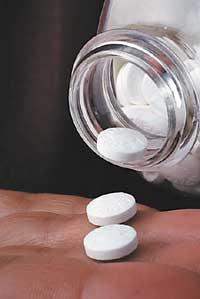When do drugs become a problem?
2014/09/01 Etxeberria, Arritxu - Lehen mailako arretako farmazialaria | Baza, Mikel - Familiako eta komunitateko medikua Iturria: Elhuyar aldizkaria

Life expectancy has grown in recent decades and has made us dream that for every health problem there can be a medicine. More and more people are taking numerous medicines to prevent or cure diseases. This situation is known to us and we almost all have around us someone who has to take a series of medications daily: father, mother, father or mother. This new phenomenon is called polymerization.
The definition of polymedication can be both qualitative (taking more drugs than are necessary or consuming inadequate drugs) and quantitative (taking five or more drugs), both of which are compatible.
In our environment, people over 65 take an average of 7 drugs daily, and the prevalence of polymerization would be between 30% and 50%. However, there are two main profiles. One, which takes several drugs in a single disease, such as the case of the patient with AIDS. And the other, the older with different health problems, many of which are chronic and for each of them the patient takes one or more drugs. This last example is the most common.
Polymedication is associated with various factors and not only clinical or pathological criteria, such as being older than 75 years or being a woman, taking certain drugs (sedatives, antidepressants, analgesics), chronic diseases, psychological factors (depression or poor perception of one's health), poor economic situation, low level of studies, loneliness, physical dependence or residence in rural areas. In addition, in the last 3 months the healthcare system, hospital admission, care for different doctors and assistance to various pharmacies has been used. It is a complex problem that coexists with a series of social problems.
Effects of polymerization
The greater number of medications, the greater the likelihood of adverse effects. A drug that may be beneficial for a single specific disease, may not be as effective in the salsa of other diseases and medications, and may cause more damage than benefits. Polymerization is mainly associated with a higher rate of hospitalization, fall, disease and mortality in older people.
On many occasions, in addition, other drugs are applied to treat the side effects produced by a drug and opens the door to the phenomenon known as "prescribing cascade" or prescription jump. This, together with the incorporation of new drugs into the list, only makes the problem worse. For example: to treat hypertension due to the consumption of anti-inflammatory drugs, a diuretic has caused gout and another medication is required to solve this problem.
A third of the older polymedicated patients will have some harmful effect derived from the drugs, increasing the frequency exponentially together with the number of drugs ingested. It should be remembered that there are no medicines that cannot produce harmful effects. However, not all side effects are significant, but they can become very serious. Authors like Barbara Starfield believe that the health system can be the third cause of death after cancer and cardiovascular disease.
However, an inadequate polymerization can be prevented and treated. The most important thing, of course, is to work the level of prevention, and its main axis would be to encourage prudent prescription from the student stage. Once it becomes a problem, it is not usually easy to solve it, but it can be alleviated with depression.
Thus, we made two proposals to prevent polymerization. First, reflect on the medicalization. We call medicalization to the transformation of any normal life problem into a medical problem or disease: menopause, school failure, shame or death of a family member. Once converted into a disease, the labels or diagnoses come: hormonal deficit, lack of attention and hyperactivity, social phobia or dysfunctional mourning. Diagnosis follows a drug based treatment: estrogens, amphetamines, and antidepressants. It is necessary to change this vision. The limits between disease and health are slippery. The desire for perfect health is an impossible dream. If the circumstances of daily life become medical problems, people lose autonomy, harmful health effects occur, and can compromise the health system itself.
Along with this, the promotion of a prudent prescription is proposed. In 2011 an article entitled "Principles of conservative prescribing" was published, with great repercussions among us. They propose 24 principles of rational prescription, classified in 6 sections. The first thing is to think beyond drugs, that is, instead of trying to remedy immediately every time a new symptom appears, first analyze and treat the causes. In addition, in the face of a health problem we must take into account non-pharmacological treatments: therapeutic exercises for back pain, diabetic diets... The second is to take into account that many symptoms are resolved spontaneously, such as back pain, sore throat, or anxiety. Therefore, they propose delaying the onset of non-urgent treatments, starting with a single drug, and avoiding drug changes in the absence of founded reasons.
In addition, a close follow-up of side effects and a prudent and skeptical attitude with new medications is recommended. In fact, there are few new drugs that represent a real breakthrough or improvement, and in their case they require little advertising to encourage their use. The main objective of the pharmaceutical industry is to sell its products by exaggerating the beneficial effects of the drug and concealing or dismissing the harmful. Therefore, information should be sought from reliable sources, based on evidence and without conflict of interest.
The last two sections consist of working together with patients to agree on health objectives and consider the effects of long-term treatment, continuously analyzing the balance between benefits and damage.
Treatment of overpolymerization
We found patients with inexhaustible lists of drugs more often than desired. What to do in these cases? Take the bull through the branches! We must rethink and analyze all the treatment from the beginning and, from the knowledge of the patient, analyze what are the diagnoses of the health problems, the indications of the treatments, the benefits and the damages, and the preferences of the person. This process, which we call depression, can lead to withdrawal, addition, alteration or reduction of the dose.
In this task it is of vital importance the general practitioner, as conductor of orchestra of polymedicated patients, since he has a global vision of the patient and knows the person, thanks to the clinical relationship of years.

Gai honi buruzko eduki gehiago
Elhuyarrek garatutako teknologia





